Key takeaways:
- Coalition building thrives on trust, shared goals, and open communication, fostering diverse perspectives for stronger advocacy.
- Collaborations across seemingly unrelated groups can uncover synergies that enhance collective impact and support for reparations initiatives.
- Effective communication, including active listening and clear language, is essential for maintaining unity and engagement within coalitions.
- Celebrating both successes and setbacks nurtures solidarity and reinforces commitment among coalition members, driving motivation for future efforts.
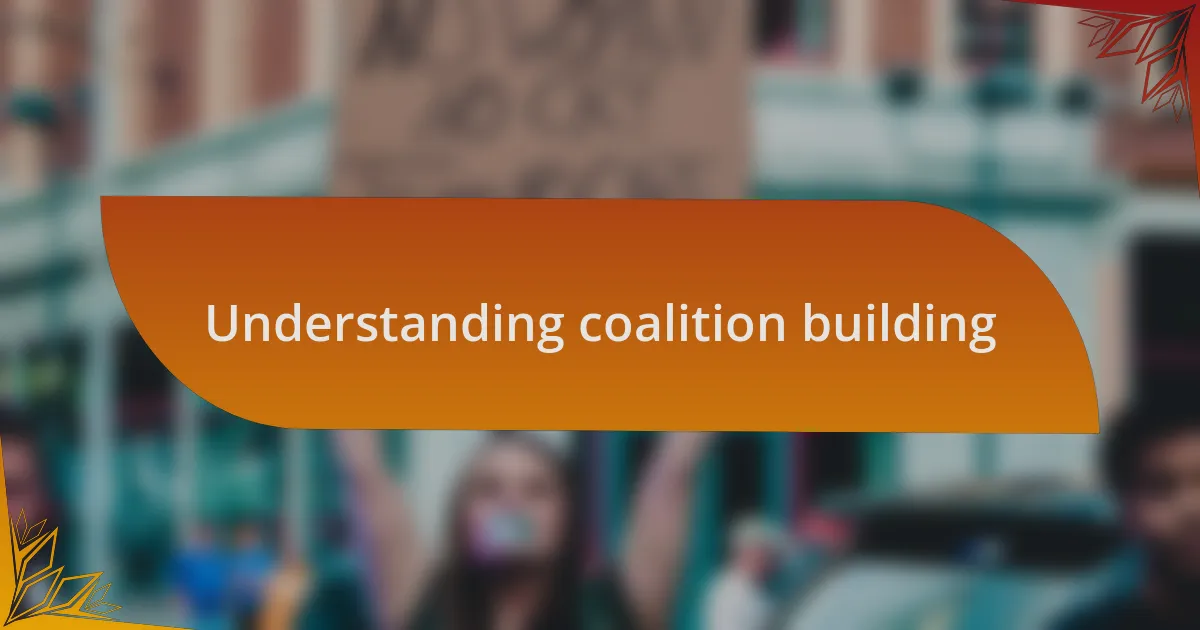
Understanding coalition building
Coalition building is more than just bringing people together; it’s about fostering relationships that are rooted in trust and shared goals. I remember a time when I worked with various community groups, each with their own perspectives and narratives about reparations. Instead of assuming a common agenda from the start, I took the time to listen deeply to their stories, which helped form a foundation of empathy and understanding.
What I’ve discovered is that a successful coalition often mirrors the diversity of its members. If we think about it, how can we advocate for sweeping changes if our voices are not representative of the communities we aim to serve? When I engaged with individuals from different backgrounds, it became clear that their unique insights enriched our conversations and strengthened our collective resolve.
Through experience, I’ve learned that open communication is key. I vividly recall a pivotal meeting where tensions ran high, and it felt like we were drifting apart instead of coming together. By creating space for everyone to voice their concerns, we transformed discomfort into collaboration, breathing new life into our coalition and reminding us that our differences could be our greatest strength.
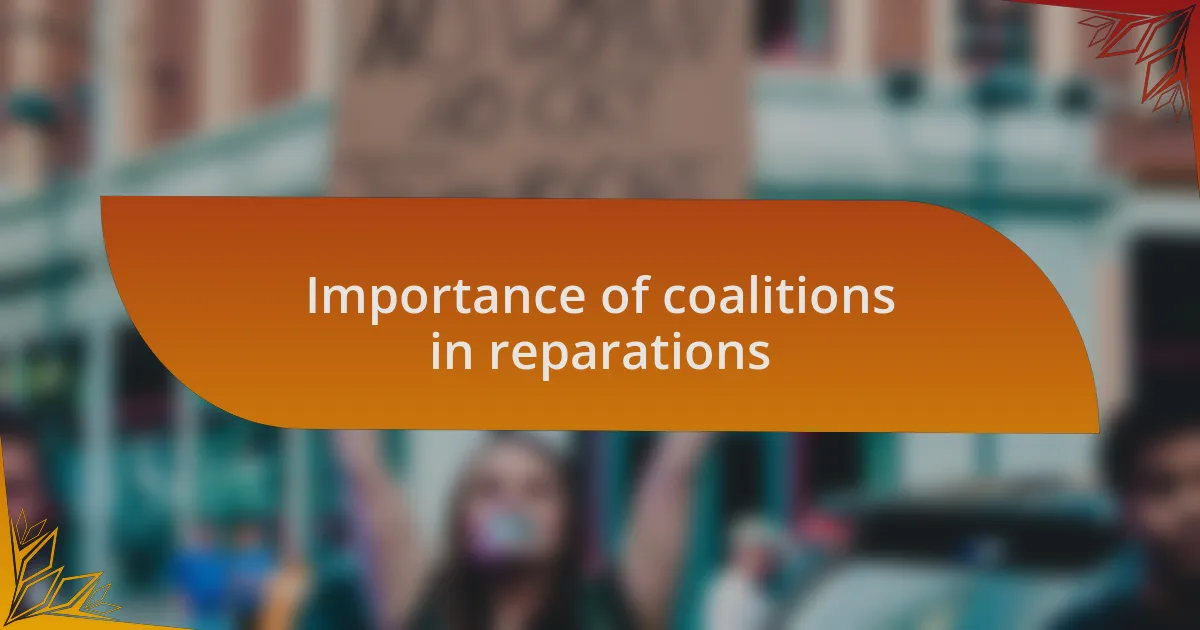
Importance of coalitions in reparations
The importance of coalitions in the reparations movement cannot be overstated. I’ve seen firsthand how a united front amplifies our voices, making it harder for policymakers to ignore our demands. When we partner with organizations that may not seem like obvious allies at first, we unlock access to broader networks and resources, enhancing our overall impact.
Consider a time when I collaborated with a group focused on education reform alongside those advocating for economic justice. Initially, it felt like we were speaking different languages, but as we explored our shared vision for equity, we unearthed a powerful synergy. This experience underscored for me that coalition building can transcend specific issues, leading us to a collective strength that makes our case for reparations more compelling.
Ultimately, coalitions create a support system that can sustain our efforts over time. There were moments when I felt disheartened, questioning if our work would lead to meaningful change. However, seeing other coalition members rally around our shared cause reignited my passion and reminded me that persistence in solidarity is essential. Could this shared commitment be the backbone of any strong reparations initiative? I wholeheartedly believe it is.
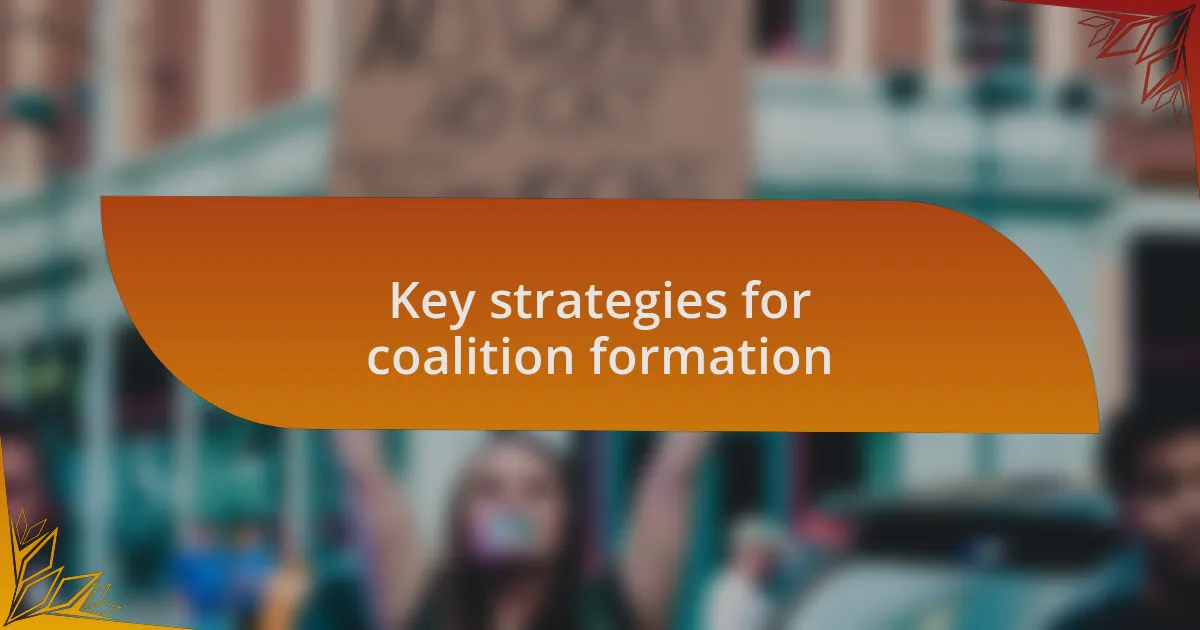
Key strategies for coalition formation
Building effective coalitions requires a clear understanding of shared objectives among diverse groups. One approach I have found effective is to organize initial meetings focused solely on listening. During one such gathering, where representatives from various backgrounds shared their stories and motivations, I was struck by the emotional connections that formed. It was a stark reminder that understanding each other’s narratives can establish a common foundation for collaboration.
Another important strategy is to identify and leverage the strengths of each partner. I recall collaborating with a grassroots organization that had a strong community presence but limited media outreach. By combining our strengths—one group’s on-the-ground credibility with my experience in strategic communications—we crafted compelling narratives that appealed to both local and national audiences. This synergy not only empowered both organizations, but also demonstrated how diverse strengths can enhance our collective capacity.
Finally, maintaining open lines of communication is crucial. I remember a coalition I was part of that faced a potential rift over differing priorities. By creating a space for honest dialogue, we could voice our concerns and ultimately find common ground. This experience taught me that prioritizing transparency fosters trust, which is essential for any coalition to thrive. Isn’t it fascinating how the act of listening can transform conflict into collaboration?
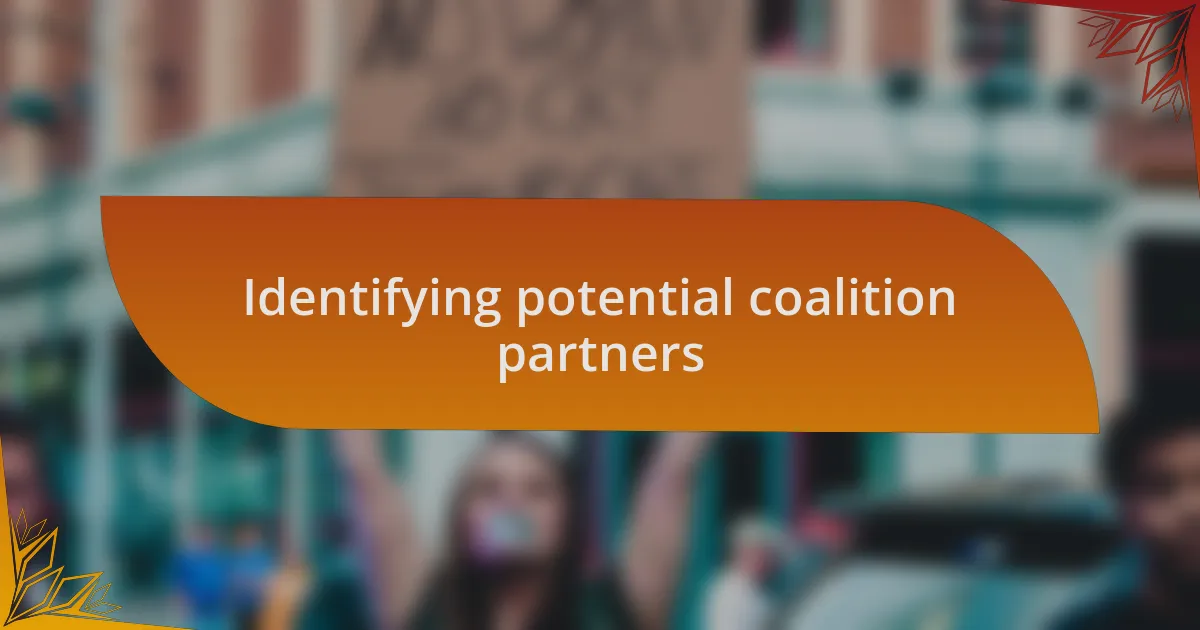
Identifying potential coalition partners
Identifying potential coalition partners is like piecing together a puzzle. Recently, I met with a local artist collective that was passionate about social justice but felt unsure about navigating the political landscape. By discussing their vision and objectives, we found that our goals aligned perfectly. It became clear that they could bring creativity and a unique perspective to the coalition, enriching our approach to advocacy. How often do we overlook unconventional allies simply because they don’t fit neatly into our standard categories?
It’s essential to dig deeper beyond surface-level interests. In my experience, I have reached out to groups that might seem disconnected from the core issue but share relevant values or experiences. I once approached a youth organization focused on climate change. At first glance, it seemed unrelated to reparations politics. However, after a few conversations, we discovered a shared commitment to systemic change that could be beneficial to both spheres. This taught me the importance of broadening my scope when identifying partners. Who else could contribute to this mission that I haven’t thought of yet?
Another critical factor is understanding the social dynamics within potential partner groups. I recall an encounter with a historical society that held a wealth of information but had predominantly older members. Initially, I assumed the age gap would be a barrier, yet I found great value in their rich narratives. By facilitating intergenerational dialogue, we not only acknowledged past injustices but also engaged younger voices in reparations discussions. It sparked a real conversation about heritage and responsibility. Isn’t it remarkable how diving into the social fabric can reveal unexpected synergies?
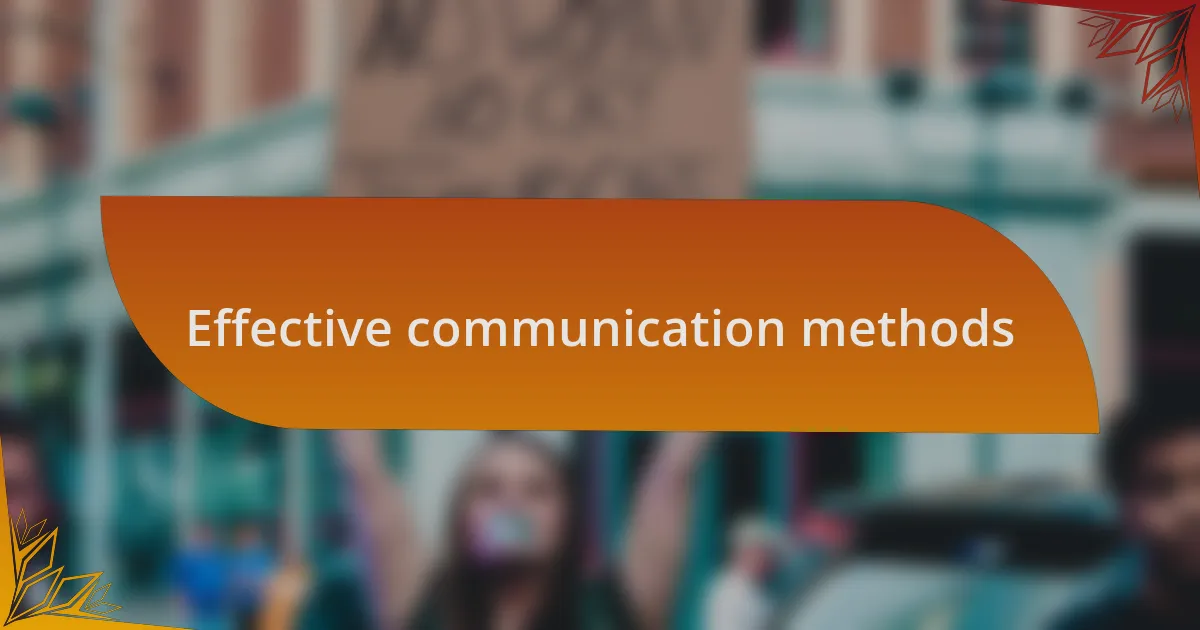
Effective communication methods
Effective communication is at the heart of building successful coalitions. I’ve found that active listening is crucial; it opens up a dialogue in which everyone feels heard. During a recent coalition meeting, I made it a point to invite each partner to share their perspectives, which not only validated their experiences but also encouraged deeper discussions about our common goals. Isn’t it amazing how listening can transform a room full of people into a unified team?
Moreover, leveraging storytelling can be incredibly powerful. I recall presenting data on reparations alongside personal narratives from affected communities. This blend of facts and lived experiences not only humanized the statistics for our partners but also created an emotional connection that fueled our collective commitment. How often do we forget that numbers can come alive with the right stories interwoven?
Additionally, I’ve learned the significance of using clear, accessible language when conveying complex ideas. In discussions about reparations, I deliberately avoid jargon, opting instead for straightforward terms that everyone can grasp. This has led to more productive dialogues and fewer misunderstandings among coalition members. Have you ever noticed how clarity fosters trust and collaboration? By prioritizing effective communication, I’ve seen our coalition thrive in ways I hadn’t imagined.
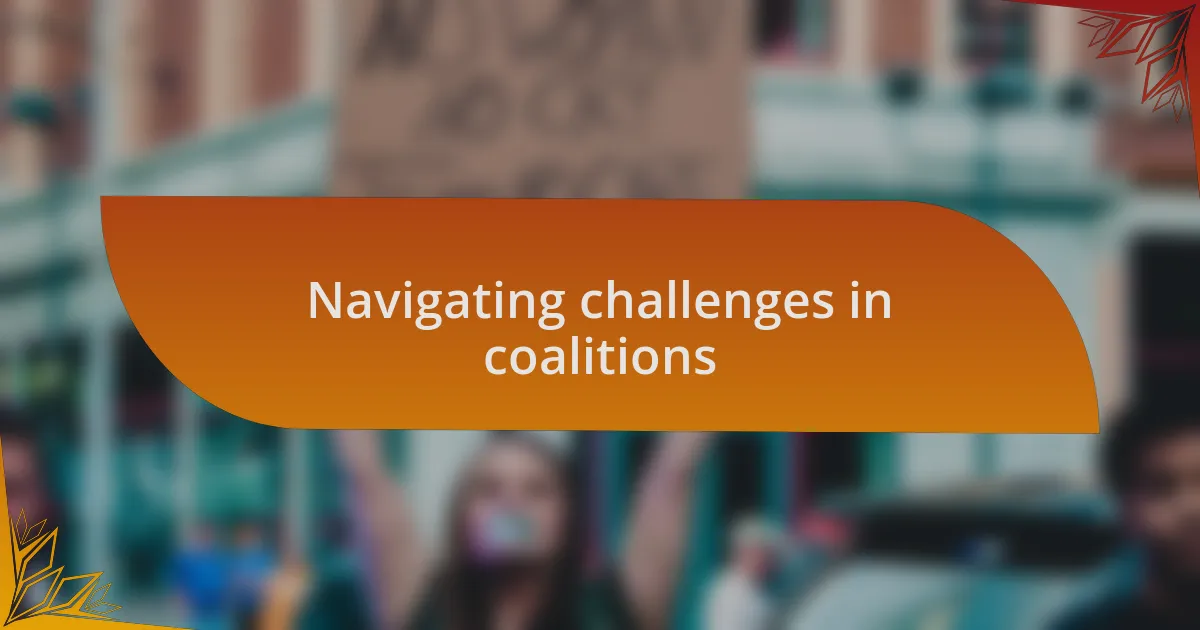
Navigating challenges in coalitions
Building coalitions often involves navigating complex relationships, which can be challenging. I remember an instance when differing priorities among partners led to tension during a planning session. It took a tough but honest conversation to reconcile our varying interests, reminding me that transparency can be the bridge that connects divergent goals. Have you ever felt stuck between conflicting objectives?
Another significant hurdle I’ve encountered is managing power dynamics. Some coalition members may feel overshadowed, leading to disengagement. I found that regularly rotating leadership roles encouraged participation and gave everyone a stake in the outcomes. It’s fascinating how a small shift in responsibility can empower quieter voices. Have you ever thought about how inclusive practices can reshape group dynamics?
Finally, staying true to the coalition’s core mission amid external pressures can be daunting. I once faced pressure to dilute our agenda for broader appeal, but I advocated for maintaining our focus on specific reparative policies. This experience taught me that clarity in purpose helps keep the coalition centered, even when faced with outside distractions. Have you reflected on how easily coalitions can drift from their initial vision?

Celebrating coalition successes and lessons
Celebrating victories in coalition building can be incredibly rewarding. I vividly recall a moment when our collective efforts culminated in the successful enactment of a local reparations initiative. The excitement in the room was palpable as we shared our wins, reinforcing for me that acknowledging progress, no matter how small, fuels motivation for future endeavors. Does celebrating these moments not make you feel more invested in the cause?
Another lesson from our coalition experiences is the importance of learning from both successes and setbacks. I remember a campaign where we fell short due to underestimating community engagement needs. While it was disappointing, this failure turned into a teaching moment that drove us to deepen our outreach efforts. Have you ever found that a misstep can lead to newfound strength and better strategies?
Additionally, sharing our stories can create a sense of solidarity among coalition members. During a recent gathering, we created a space for each member to express their unique contributions and the challenges they had overcome. This exercise not only brought tears to our eyes but also reinforced a powerful lesson: our stories connect us, binding our energies toward a common goal. How much more powerful can our collective narratives become when shared openly?